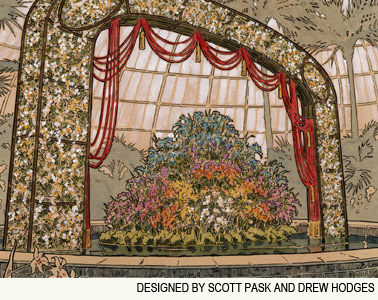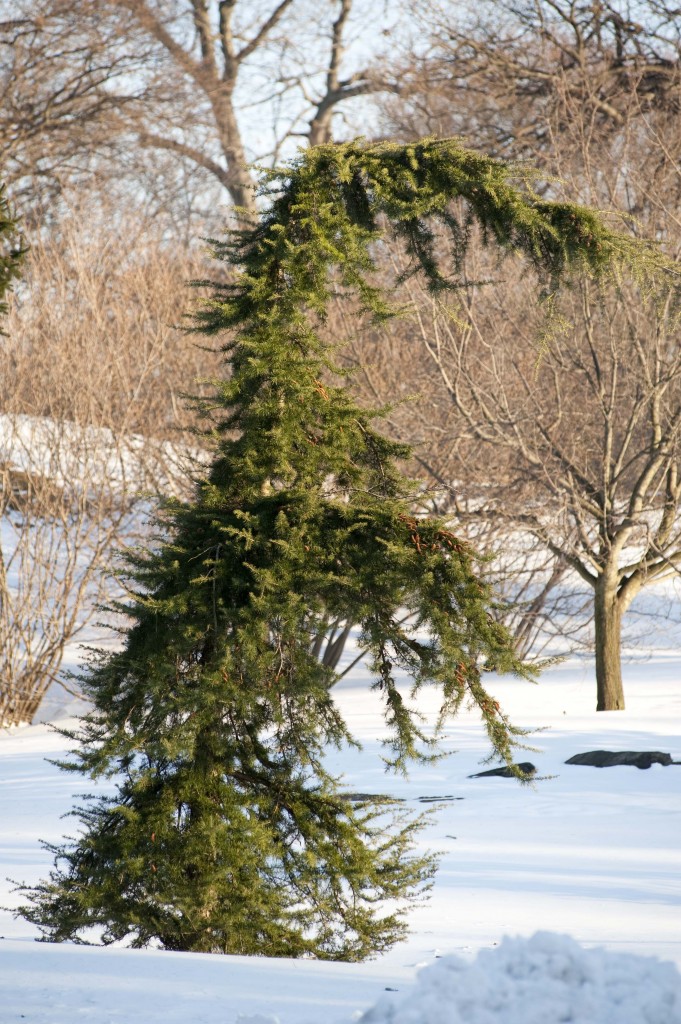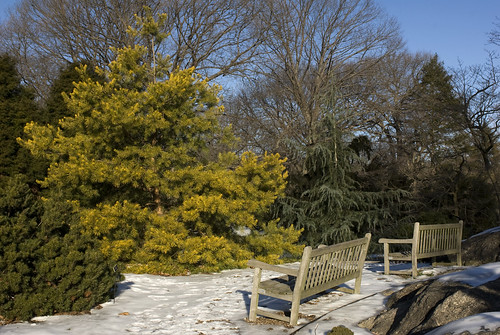Inside The New York Botanical Garden
gardening tips
Posted in Gardening Tips on March 8 2011, by Sonia Uyterhoeven
 Many of you may be asking yourself; ‘what do plant breeders do in their spare time’? This thought never crossed my mind until I attended an in-house lecture at NYBG by an Israeli plant breeder. The plant breeder in question, Harry Paris, was born and raised in Brooklyn and has spent the past 30 years working and living in Israel.
Many of you may be asking yourself; ‘what do plant breeders do in their spare time’? This thought never crossed my mind until I attended an in-house lecture at NYBG by an Israeli plant breeder. The plant breeder in question, Harry Paris, was born and raised in Brooklyn and has spent the past 30 years working and living in Israel.
He opened the lecture by explaining his interest in history; as a plant breeder he maintained that it is easier to know where you are going if you know where you have come from. That’s food for thought whether you are discussing Curcurbit or life in general.
What is a Curcurbit? I was once named one of my home gardening demonstrations ‘Curcurbit Crafts’ and was asked to change the title due to the concern that the public would not know what they were in for. I tamed the title to ‘Autumnal Centerpieces’ and ‘Groovy Gourds’. Curcurbitaceae is the botanical family that includes cucumbers, squashes, gourds, pumpkins and melons.
Dr. Paris proceeded to explain how you investigate the history of a Curcurbit. He used an interdisciplinary approach where he drew information from botany, horticulture, food use, archeology, history, linguistics and iconography.
As the talk unfolded it became apparent that Dr. Paris was the Sherlock Holmes of the cucumber. He was tracking references back into the past – back to the Romans, the ancient Greeks, and ancient Egyptians.
Don't curb your curcurbit knowledge! Read on for more of Dr. Paris' 'cuke history lesson
Posted in Gardening Tips on March 1 2011, by Sonia Uyterhoeven
 In ancient Greek the word for theatre (theatron) means a place for seeing. As the New York born actress, Stella Adler once said ‘It is the place people come to see the truths about life’. The Orchid Show: On Broadway with the award-winning set designer Scott Pask and image maker Drew Hodges will be celebrating the universal truth that myriad members of the Orchidaceae family are some of the biggest divas in the plant world.
In ancient Greek the word for theatre (theatron) means a place for seeing. As the New York born actress, Stella Adler once said ‘It is the place people come to see the truths about life’. The Orchid Show: On Broadway with the award-winning set designer Scott Pask and image maker Drew Hodges will be celebrating the universal truth that myriad members of the Orchidaceae family are some of the biggest divas in the plant world.
In the 19th century, Covent Garden used to rely on the brilliant white light produced by lime or calcium flares to illuminate their leading ladies hence the expression “in the limelight”. Every year when the long and dreary winter extends endlessly the Garden explodes with light, color and sensual perfumes from the Orchid Show.
Brassia or spider orchids will send shivers up your spine; Oncidium or dancing ladies mimic tiny flamenco dancers dangling from their flowery spikes and their perfume is often enticing. Ondontoglossum will grab you with the barbs on their labellum; mother natures’ way of giving insects something to take hold of when they feed and pollinate. One of my favorites, Zygopetalum will be giving the ensemble a run for their money with their exquisite hyacinth perfume.
Leave the lime flares at home – most of these orchids like bright dappled light similar to the conditions of their native rainforest homes. The Zygopetalum is semi-terrestrial and prefers a slightly damp moisture-retentive mix that is capable of providing good drainage. The rest of the troupe are epiphytic and do best if you saturate them with water (a heavy rain storm) and then let to begin to dry out. Many of the orchids you will find in the show are complex hybrids that are easy to care for.
With the theatrical backdrop, the producers of the show will make sure that they look their best for opening night. These ladies have their routine down and will not disappoint. The Orchid Show will be open on Saturday March 5th (Friday, March 4th for Member’s Only) and runs until Monday, April 25th.
Home Gardening Demonstrations on basic orchid care will be given on Saturdays and Sundays at 2 and 3:30 p.m. There will also be Cabaret performances in the afternoon. Visit our website for full details of events.
Posted in Gardening Tips on February 22 2011, by Plant Talk
It’s still early yet, but time to start thinking about what we are going to plant in our containers this year. The catalogs have been out now for a while and we have had our chance to peruse what is new and exciting in the horticultural world.
The new options this year are a lot of fun and they are not shy. Ball Horticultural Company has come out with a series of three velvety black petunias that will knock your socks off – and yes – black means black.
Petunia ‘Black Velvet’ is the pure black petunia that is a soft and sensuous as it name suggests. ‘Phantom’ and ‘Pinstripe’ are two variations on the theme. The former has a bright yellow star pattern that is offset by the black background while the latter has the same pattern in a smaller muted cream and bleeding pink color.
The grower reminds us the ‘everything goes with black’ – and it should. These are three very adaptable container companions. They have a nice compact mounding habit – 8-12 inches in height and spread. They should be widely available this year. Burpee is selling the all black petunia under the name ‘Black Cat’.
If black is the color of the year – you might also be interested in Calibrachoa Superbells ‘Blackberry Punch’. The flowers are magenta but the large throat on this plant is velvet black. ‘Blackberry Punch’ is a trailer that grows 12 inches high and wide yet will spill over your container and trail up to 36 inches.
Read More
Posted in Gardening Tips on February 15 2011, by Plant Talk
Most of us love sweet peas. The problem is that they are outrageously expensive at the florist, quite expensive at the farmer’s markets and while they are not difficult to grow it is always a challenge to get the timing right so that they are blooming profusely before the heat of the summer knocks them back.
If we travel back in time and look at the history we may acquire a better understanding of the flower and be able to make informed decisions when we choose a cultivar to grow in our gardens.
There are species sweet peas that are fabulous but do not have the multitude of frilly flowers that modern cultivars possess. There are also ‘Old-fashioned Types’. These are the sweet peas that have been on record since 1800 but are generally dated back to the 1700’s.
You will recognize a few of these from seed catalogs – Lathyrus odoratus ‘Cupani’s Original’ and ‘Painted Lady’ are two. These sweet peas have a wonderful fragrance and while the flowers are a little smaller than subsequent introductions their persistence on the market is a testament to their success. They tend to flower on the early side for sweet peas and are reasonably heat tolerant.
In the 1880’s a British gardener named Henry Eckford transformed the sweet pea into one of the most sought after blooms in Britain. He produced what we know as the Grandifloras. These hybrids, as the name suggests, produced a much larger flower, came in a multitude of colors and had a wonderful fragrance. Many of these cultivars can still be found on the market such as ‘Jewel of Albion’, ‘Queen of the Night’, ‘Miss Willmott’ and ‘Perfume Delight’.
Read More
Posted in Gardening Tips on February 8 2011, by Plant Talk
One of the new stars in the world of native plants these days is Uvularia perfoliata ‘Jingle Bells’. This woodland spring wildflower is indigenous to the East Coast west to the Mississippi. It generally has soft green leaves, yellow bell flowers and an arching demeanor. This new introduction has light green leaves with large white streaks around its border and into its interior. You can find this at Plant Delight Nurseries.
Another native that will attract the attention of homeowners is Amsonia ciliata ‘Spring Sky’. This sturdy native can be found from North Carolina down to Florida and west to Missouri. Blue star (its common name) has won the hearts of many by being a low-maintenance perennial that can grow in sun or part-shade and has the added benefit of being deer and rabbit resistant.
This new cultivar is a compact version of the native – reaching only 2 feet tall by 2 feet wide. It has pale blue flowers in the spring that are slightly larger than the native and fine, feathery foliage that turns a beautiful yellow hue in the fall. This new introduction comes from North Creek Nurseries.
For those of you looking for a splash of color later in the season, there is a new goldenrod on the market named Solidago ‘Solar Cascade’. ‘Solar Cascade’ size falls somewhere in between the compact ‘Golden Fleece’ and the majestic ‘Fireworks’. ‘Solar Cascade’ is a clump forming perennial that is drought tolerant once established.
‘Solar Cascade’ has glossy green foliage and arching sprays of golden flowers late in the summer. It will pair beautifully with many of your late season staples – ornamental grasses, New York ironweed (Vernonia noveboracensis), medium sized dahlias and annual late season salvias.
A new cultivar of an ornamental grass that is indigenous to the dry plains of central North America is hitting the market by storm this year. Sometimes referred to as mosquito or blue grama grass, the new cultivar is named Bouteloua gracilis ‘Blonde Ambition’.
Read More
Posted in Gardening Tips on February 1 2011, by Plant Talk
 Two weeks ago our intellect and imagination was stimulated by the first in our three part Annual Winter Lecture Series. The Thursday morning lecture series (from 10am – 12pm) is entitled ‘Explore Your Greener Side’. The monthly lectures are scheduled for (January 20), February 17 and March 17.
Two weeks ago our intellect and imagination was stimulated by the first in our three part Annual Winter Lecture Series. The Thursday morning lecture series (from 10am – 12pm) is entitled ‘Explore Your Greener Side’. The monthly lectures are scheduled for (January 20), February 17 and March 17.
The sessions begin with a brief opening talk that translates into an amuse-bouche for the main speaker. The opening remarks in January were given by Eric Sanderson, author of Mannahatta. Sanderson blends intellect, charisma and a down-to-earth quality into an infectious mix. He spoke of the social and environmental/ecological choices that we have when planning the future of our city.
Sanderson takes what seems like an impenetrable urban environment and revitalizes it by giving us insight into what it must have looked like before the concrete jungle was erected. He provides city planners, landscape architects and visionaries with the raw materials to embrace and recreate the natural landscape; challenging us to change how we think about the urban environment.
Our featured speaker in January was the renowned urban landscape architect, Michael Van Valkenburgh (pictured, with New York Botanical Garden president Grerory Long). Van Valkenburgh started with the premise that ‘ecology and cultural situations are intimately connected these days’. While it can be tempting to separate ecology from urban development – more forward thinking landscape architects and city planners are integrating the two.
Read More
Posted in Gardening Tips on January 18 2011, by Sonia Uyterhoeven
 Last week we looked dwarf conifers as container plants. Single containers – particularly with a small to medium sized tree or shrub can happily fill a corner on a patio. Sometimes, however, they look a little lonely, particularly if they don’t have enough pizzazz or weight to hold up on their own.
Last week we looked dwarf conifers as container plants. Single containers – particularly with a small to medium sized tree or shrub can happily fill a corner on a patio. Sometimes, however, they look a little lonely, particularly if they don’t have enough pizzazz or weight to hold up on their own.
Many container plants look better when clustered in groups to form miniature landscapes. There is great latitude in how a homeowner can approach this task. The containers could all be the same giving a uniform look or you could go for a more eclectic arrangement of colorful and expressive pots. One way will give a formal feel to the arrangement while the other will give it an ‘arts and crafts’ feel.
You likewise have endless possibilities with your plant choices. Are you trying to create the feel of a miniature woodland on your patio, replicate a foundation planting or have a foray into a mixed perennial garden? It is important to have a vision of what you would like to create before you start selecting your container plants.
Read More
Posted in Gardening Tips on January 4 2011, by Sonia Uyterhoeven
 |
Sonia Uyterhoeven is Gardener for Public Education. |
 Last week we took a look at some of the more unusual conifers that grace the entrance of the Benenson Ornamental Conifer Collection at The New York Botanical Garden. This week, I am going to go for some homeowner appeal and discuss miniature and dwarf conifers.
Last week we took a look at some of the more unusual conifers that grace the entrance of the Benenson Ornamental Conifer Collection at The New York Botanical Garden. This week, I am going to go for some homeowner appeal and discuss miniature and dwarf conifers.
The American Conifer Society classifies conifers by growth rate: miniature conifers grow less than one inch per year, dwarf conifers grow 1-6 inches per year, intermediate conifers grow 6-12 inches per year and large conifers grow more than a foot per year.
Miniature and dwarf conifers are basically trees disguised as shrubs – they can snuggle up to your perennials in an unobtrusive way and are wonderful additions to your container gardens. You often see the botanical epithet ‘nana’ attached to cultivar names – it means dwarf.
In the perennial garden, dwarf conifers provide winter interest. They give a nice permanent structure to the plantings. Many of the conifers have a graceful, architectural structure that flows effortlessly and mingles gregariously in amongst the drifts of perennials.
Read More
Posted in Gardening Tips on December 27 2010, by Sonia Uyterhoeven
 |
Sonia Uyterhoeven is Gardener for Public Education. |
 The Benenson Ornamental Conifer Collection has over 400 specimens in a 15 acre area. While a few of the conifers such as the bald cypress (Taxodium distichum), dawn-redwood (Metasequoia glyptostroboides) and larches (Larix sp.) are deciduous most of them are evergreen making this part of the garden an ideal visiting spot during the winter months.
The Benenson Ornamental Conifer Collection has over 400 specimens in a 15 acre area. While a few of the conifers such as the bald cypress (Taxodium distichum), dawn-redwood (Metasequoia glyptostroboides) and larches (Larix sp.) are deciduous most of them are evergreen making this part of the garden an ideal visiting spot during the winter months.
Conifers bear their seeds in cones. Most of them have needle or scale-like leaves. This feature gives their leaves a low-surface area that helps them conserve water and allow them to thrive in difficult situations.
While our Ross Conifer Collection features species, the Benenson Ornamental Conifer collection offers examples of cultivated varieties. Some ornamental conifers are ubiquitous in the nursery trade and others are rare finds that are generally worth searching out. They often have interesting forms, textures and foliage. They offer the homeowner much needed winter interest, add to the architecture of your garden and are great additions to any landscape.
Let’s start with the entrance of this garden and look at a few of its residents. At the entrance off to the side are two young cedars. One is a cedar of Lebanon named ‘Beacon Hill’ (Cedrus libani ‘Beacon Hill’). This is a dwarf specimen that has bright green foliage and a lovely sprawling habit that gracefully contorts itself like a ballerina.
Adjacent is a Himalayan cedar named Cedrus deodara ‘Shalimar’. This cedar has blue-green needles and light and airy branches that stretch outward in a raised horizontal fashion, drooping slightly at the tip. The shape of the branches looks like angel’s wings taking off in flight.
Two Sargent’s weeping hemlock (Tsuga canadensis ‘Pendula’) line the face of the rock wall. This graceful hemlock has no dominant leader like the Eastern hemlock (Tsuga canadensis) and the branches grow horizontally in an arching manner. It was originally discovered growing as a seedling near Beacon, New York. The Benenson has several fine specimens gracing the entrance of the garden.
One of my favorite additions to the collection can be found right near the rustic stone seating area at the entrance to the garden. It is the variegated Himalayan pine (Pinus wallichiana ‘Zebrina’). The variegated Himalayan pine has incredibly long 7 inch needles that are covered with alternating stripes in green and gold. The needles look more like a porcupine’s quill then a conifer’s needle.
These are just a few highlights that decorate the entrance to the collection. Enter the garden and you will find a vast collection of interesting ornamental conifers – some ideal for homeowners with small spaces – others specimens best left to the expansive grounds of a botanical garden.
Posted in Gardening Tips on December 13 2010, by Sonia Uyterhoeven
 |
Sonia Uyterhoeven is Gardener for Public Education. |
Let’s look at simple ways to dress up our homes for those of us who have great aspirations and little time.
Around the holiday times we like to brighten up our homes with flowers. If you buy a nice bouquet of roses you can gussy them up for the holidays with a few simple tricks. An easy way is to hide the stems with a cranberry frog. Take a bag of cranberries (hard ones) and wash them clean. Remove any that are soft. Pour the bag into your vase and fill with water. The cranberries will keep the stems in place and create a pretty effect in a clear vase. They will float a bit at first but then settle down. The cranberries last for about a week. This is best done in a nice wide clear vase to show off the cranberries.
When filling your vase think beyond flowers. Often people embellish our floral arrangements with ferns or magnolia leaves. At this time of year substitute holiday greens in for the traditional greenery. White pine, incense cedar and hollies make three good options.
You can also place holiday ornaments into the mix. In craft stores you will find wired stakes of different sizes. Wire the ornament to the stake and stagger the ornaments throughout the greenery.
Last year, I decided to fix some lady apples onto small green stakes and add then to the arrangement. While I was breaking the rules for good arrangements (fruit and flowers don’t mix well because the ethylene gas emitted by fruits will cut down on the life span of the flowers) it certainly looked nice and lasted long enough to make me happy.
Here are a few tips to make your life easier. Search the florists, craft stores and supermarkets for interesting decorative supplies. Pine sap can easily be removed from clothing with rubbing alcohol. For your tools and hands try hand sanitizer, baby oil, WD-40 or anything oily.
Roses are wonderful but so many times you bring them home and they droop within the first few days. Cut the roses at a 45° angle with either your pruners or a sharp knife. Place immediately into lukewarm water. Floral preservative increases the longevity of flowers by up to 75% so it is worth the small investment. If you don’t have floral preservative handy there are many homemade recipes. Here is just one:
Take 1 teaspoon of sugar, 1 teaspoon of bleach and 2 teaspoons of lemon juice and 1 quart of lukewarm water. The bleach keeps the mixture clean and free from bacteria, the sugar feeds the flowers and the citrus helps the flowers to take up water by making it slightly acidic.
There are many methods for reviving drooping flowers. One that works effectively for roses is to heat water up so that it is very hot (almost but not quite boiling). Dip the stems of the drooping roses into the hot water for 30 seconds keeping the flowers away from the steam. Re-cut the stems and place them back in a clean vase. They should revive within 15 to 30 minutes.

 Many of you may be asking yourself; ‘what do plant breeders do in their spare time’? This thought never crossed my mind until I attended an in-house lecture at NYBG by an Israeli plant breeder. The plant breeder in question, Harry Paris, was born and raised in Brooklyn and has spent the past 30 years working and living in Israel.
Many of you may be asking yourself; ‘what do plant breeders do in their spare time’? This thought never crossed my mind until I attended an in-house lecture at NYBG by an Israeli plant breeder. The plant breeder in question, Harry Paris, was born and raised in Brooklyn and has spent the past 30 years working and living in Israel.
 In ancient Greek the word for theatre (theatron) means a place for seeing. As the New York born actress, Stella Adler once said ‘It is the place people come to see the truths about life’.
In ancient Greek the word for theatre (theatron) means a place for seeing. As the New York born actress, Stella Adler once said ‘It is the place people come to see the truths about life’. 


